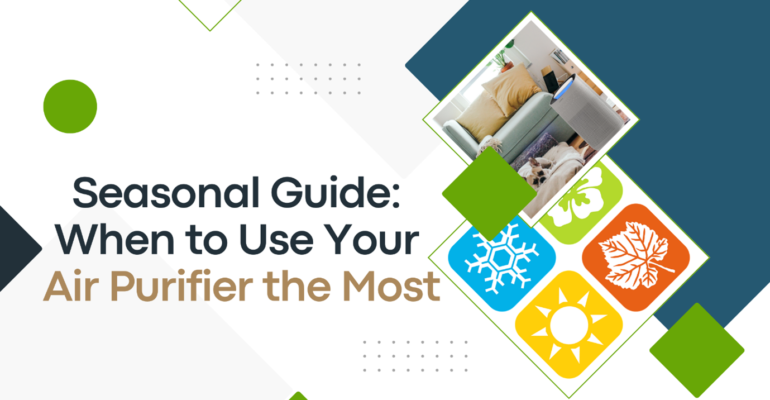Seasonal Tips for Maximizing Air Purifier Effectiveness.
August 2, 2024 2024-08-02 10:39Seasonal Tips for Maximizing Air Purifier Effectiveness.

Seasonal Tips for Maximizing Air Purifier Effectiveness.
Seasonal Tips for Maximizing Air Purifier Effectiveness in Different Rooms
Air purifiers are essential for maintaining clean and healthy indoor air, especially as seasonal changes affect air quality. Each season brings unique challenges and considerations effectively in various rooms of your home. This guide provides practical tips for optimizing your air purifier’s performance throughout the year, ensuring you enjoy clean air no matter the season.
Spring: Allergy Season and Pollens
Spring is synonymous with blooming flowers and increased pollen counts, which can trigger allergies and respiratory issues. To maximize your air purifier’s effectiveness during this season:
- Place Purifiers in Key Areas: Focus on bedrooms and living rooms where you spend most of your time. These areas are crucial for maintaining comfort and minimizing allergen exposure.
- Use HEPA Filters: Ensure your air purifier has a high-efficiency particulate air (HEPA) filter, which is effective at capturing pollen and other airborne allergens. Regularly replace or clean the filter as needed.
- Keep Windows Closed: While it’s tempting to open windows for fresh air, keep them closed during high pollen counts to prevent allergens from entering your home.
- Regular Maintenance: Clean or replace filters frequently to ensure they are operating at peak efficiency. Spring cleaning is also a good time to vacuum and dust surfaces that can accumulate allergens.
Summer: Heat and Humidity
Summer introduces heat and humidity, which can affect air quality and the performance of your air purifier. To manage these conditions:
- Monitor Humidity Levels: High humidity can lead to mold growth and other issues. Use a dehumidifier in conjunction with your air purifier to keep indoor humidity levels between 30-50%.
- Optimize Airflow: Place your air purifier in rooms with good airflow to help distribute clean air more effectively. Avoid placing it near walls or furniture that might obstruct airflow.
- Outdoor Air Quality: In summer, outdoor air quality can impact indoor air. If you use an air purifier with an activated carbon filter, it can help reduce the impact of outdoor pollutants.
- Routine Checks: Ensure your air purifier’s filter is clean and replace it if necessary. The increased use during summer months can cause filters to fill up more quickly.
Fall: Dust and Allergens
As fall approaches, dust and allergens from fallen leaves and increased indoor activities become prominent. Here’s how to manage these changes:
- Focus on High-Traffic Areas: Place air purifiers in high-traffic areas where dust and allergens are most likely to settle. Living rooms, kitchens, and home offices are key areas to address.
- Maintain Indoor Air Quality: Regularly vacuum carpets and upholstery, and clean surfaces to reduce the amount of dust and allergens in the air.
- Check Air Purifier Settings: Some air purifiers have settings specifically designed for dealing with dust and allergens. Adjust these settings as needed to improve air quality.
- Seal Gaps: Ensure that windows and doors are well-sealed to prevent outdoor allergens from entering your home.
Winter: Indoor Air Quality and Heating
Winter brings colder temperatures and the use of heating systems, which can affect indoor air quality. Here’s how to optimize your air purifier’s performance during winter:
- Positioning Near Heating Sources: Place your air purifier away from heating vents or radiators to avoid disrupting airflow and to ensure even distribution of clean air.
- Manage Dry Air: Winter heating can dry out the air, leading to irritation of the respiratory tract. Consider using a humidifier in conjunction with your air purifier to maintain optimal indoor humidity levels.
- Check for Carbon Monoxide: Ensure your air purifier has a filter capable of capturing volatile organic compounds (VOCs) and carbon monoxide, which can be a concern with certain heating systems.
- Regular Filter Checks: The winter months may increase the use of your air purifier. Check and replace filters more frequently to maintain its effectiveness.
General Tips for All Seasons
- Choose the Right Size: Ensure your air purifier is appropriately sized for the room it is placed in. An undersized unit will not effectively clean the air, while an oversized unit may be inefficient.
- Optimize Placement: For best results, place your air purifier in a central location in the room where air can circulate freely. Avoid placing it in corners or behind furniture.
- Regular Maintenance: Follow the manufacturer’s recommendations for cleaning and maintaining your air purifier. Regular upkeep is crucial for long-term performance.
- Consider Air Quality Monitors: Using an air quality monitor can help you track indoor air quality and make adjustments to your air purifier settings as needed.
By tailoring the use of your air purifier to seasonal conditions, you can ensure that it performs optimally throughout the year, providing you with clean and healthy indoor air. Implement these seasonal tips to address the specific challenges each season brings and maintain a comfortable living environment for you and your family.



